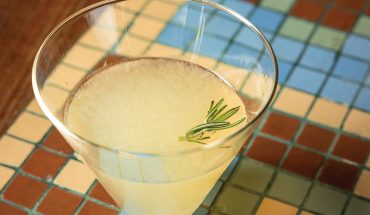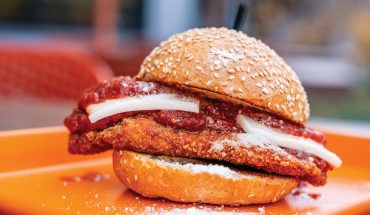by Dean McCord
photographs by Nick Pironio
The town of Ninety Six, S.C., might be known to history buffs as an important backcountry outpost for British forces during the Revolutionary War. But few people know that Ninety Six is the hometown of one of North Carolina’s most dynamic chefs, Steven Greene of Cary’s An restaurant. The 33-year-old Greene has had an alchemist’s effect on the restaurant since taking over in January 2012, turning a solid but unspectacular restaurant into one of the Triangle’s premier dining spots, only the third restaurant to be given a five-star review by The News & Observer’s Greg Cox.
“A two-hour-plus parade of so many courses I lost count, the meal was the most memorable I’ve had since I dined several years ago at McCrady’s, the James Beard Award-winning restaurant in Charleston – where, as it happens, Steven Greene has also worked,” Cox wrote last May.
How did a young, small-town Southern boy of French and Scotch-Irish descent – a cook with no formal training, and no direct connection with Asian food – become such a force of Asian cuisine?
He’ll tell you it comes down to relationships. With line cooks and master chefs, with native Asian cooks, with ingredients and techniques he came to love, and with mentors he found along the way.
Today at An, Greene serves up dishes like Siam noodles, duck curry, chili prawns and Thai wings, and features ingredients like tamarind and a variety of exotic citrus fruits like yuzu, sudachi, and kabosu. It’s a long way from Ninety Six, but Greene, who has wholeheartedly adopted the intricate nuances of a multitude of Asian cuisines, is right at home.
“Steven is all about details,” says Herons chef Scott Crawford, who has worked with Greene in two kitchens and over several years. “Fine, fine details. Things that other people don’t even recognize.”
An athlete’s drive
A solid athlete in his youth, Greene still looks the part: fit and trim in his chef’s whites, hair gelled in a boyish faux-hawk. He exudes confidence. He had opportunities to play sports in college, but competition on the field was not the source of his inspiration and motivation – food was.
As a teenager, he worked at a French restaurant in nearby Greenwood, initially as a dishwasher, then as a waiter, and finally as line cook. After high school, the chef he was working with suggested Greene head to Charleston and jump right into the business. He did. It was at the world-renowned McCrady’s Restaurant that then-chef Michael Kramer exposed Greene to Asian cuisine for the first time with a handful of exotic ingredients.
Next came a job at the acclaimed Dining Room at Woodlands Resort and Inn outside of Charleston, where Greene rose quickly through the ranks. He says his approach to cooking also grew. “At first, I treated my job as an extension of who I was in high school – an athlete – so cooking to me was a competition. How fast I could prep. How perfectly I could execute a dish. When I became executive sous chef, I became more than a cook. I took ownership of bringing something special to the table.”
It was also at Woodlands that Greene’s exposure to Asian cuisine broadened. Executive Chef Ken Vedrinski had spent a number of years working in Thailand, and he introduced Greene to ingredients, techniques, and ways to incorporate them into the menu of a European-style, high-end restaurant.
Greene took that education and ran with it, opening his own restaurant at the age of 25 in Greenville, S.C. Devereaux’s (after his middle name) became a huge success. Its menu was “all over the map.” Some dishes had Asian elements in them, as they had at the Woodlands, but no one would have called Devereaux’s an Asian restaurant.
Then, after four years of running his own show, worrying about payroll and other management concerns, Greene decided to focus solely on cooking again. He accepted an offer to join Scott Crawford, with whom he’d worked at Woodlands, as chef de cuisine at Herons Restaurant in Cary’s Umstead Hotel and Spa.
At Herons, Greene continued to dabble with Asian ingredients and was encouraged to experiment further. He took a trip to Thailand and Malaysia with Chicago chef Curtis Duffy, immersing himself in the local food traditions. But Greene was still by no means an Asian chef. He knew a lot about the food, the culture, and the techniques, but he hadn’t even mastered how to use what he refers to as the most important tool of the Asian kitchen: the wok.
At the end of 2011, that was about to change. Greene was approached by Jim and Ann Goodnight of SAS, owner of both the Umstead and An, with an offer: take over An, which had gotten stale in its food, ordinary in its service, and lacked direction. Greene knew how to cook and run a kitchen. He had a fundamental understanding of Asian food. But taking over a restaurant that was exclusively Asian would be an immense challenge.
Built-in knowledge
This time, there wasn’t a mentor or boss to help teach Greene about Asian food. Help instead came from his new employees, the existing cooks and sushi chefs at An, nine of whom are Asian by descent and know the region’s cuisine inside and out.
His education began when Chun Shi, a line cook and native of Shanghai, invited Greene to her house for a Chinese and Korean family-style meal. Greene says he realized at this meal that Asian food was immeasurably complex, with a soul bigger than its ingredients and techniques.
Understanding that his staff had a much deeper understanding of these cuisines and their mysteries than he had, Greene became a sponge, learning everything he could. He discovered new ingredients and techniques and also absorbed the ethos of the various styles of Asian cooking: the distinctions between the cuisines of Thailand, Malaysia, Japan, and regions of China.
At the same time, Greene believed his cooks and front-of-the-house staff needed a new direction, a new way of approaching their job. His changes were slow at the start. He provided standard uniforms to create more of a team-like atmosphere and made just a few tweaks to the menu, removing non-Asian dishes that had become commonplace, such as truffled polenta. And slowly, over the next eight months, with a lot of input from his staff, An became a restaurant transformed.
The menu was completely new, with more complex flavor combinations, more exotic and unusual ingredients – and all with a commitment to the Asian ethic. Western-based stocks, like chicken and beef, were replaced with Asian stocks like dashi, the tuna- and kelp-based stock essential to Japanese cooking.
He didn’t hesitate to source the best and freshest ingredients, including Madai snapper from Hawaii, or authentic Kobe beef from Japan. He says he knew the market was ready for luxury ingredients.
And he changed more than the menu. Plating of food became more interesting. Traditional china was replaced with shields of slate or rustic pottery. The entire cocktail program was reinvented. Even though Greene made it a more formal restaurant, he did not want it to get stuffy; he still wanted customers to be at ease. So he tried to give the food a sense of whimsy: duck curry served in a Mason jar, for instance.
But in the end, Greene says, what’s on the plate is where his Asian journey is manifested, where An’s dishes demonstrate a balance and harmony, not only of flavors – the salty and sweet and sour and earthy – but also the colors, shapes and textures. Each plate is designed to be a work of delicious art.
Today, An – with more than 200 seats, not a small restaurant – fills up every night of the week. Greene credits his mentors, who gave him a foundation in understanding Asian ingredients, but it is his staff whom he truly praises, the line cooks and sushi chefs like Chun Shi, EJ Pyon and Hyun-Woo Kim. They are the ones who made the difference, he says. They are the ones who embraced this good-looking Southern boy from little ol’ Ninety Six and made him an icon of Asian cuisine. And, just like in his high school athletic days, he’ll tell you, it was all a team effort.
Chicken and Mushroom Ramen
The basis of most ramen dishes is the dashi, which is a broth of kombu, a dried kelp, and bonito, a dried, shaved tuna. This version boosts the flavor of the dashi with chicken, dried shiitake mushrooms, white miso and a mushroom soy. Use plain ramen noodles.
Ramen dishes can be topped with any ingredients on hand. Corn, meat, Japanese fish cakes, herbs, scallions, bean sprouts and eggs (poached, hard or soft boiled) all make good toppings. Simple homemade pickles of cucumber, rice wine vinegar, sugar and salt also work well as a topping. This recipe is for six people, but you can make the dashi in advance, making enough noodles for your present need, and freeze the remaining dashi. All ingredients are available at an Asian market.
For the Dashi:
4 quarts water
1 ounce package of kombu (dried kelp)
1 ounce package of bonito flakes
1 whole chicken, giblets removed
1 ounce dried shiitake mushrooms
2 teaspoons mushroom soy sauce
1 Tablespoon white miso
Put the kombu in a large pot, cover with the water, and soak for 20 minutes. Heat the pot until small bubbles begin to appear around the edges. Remove the kombu from the pot. Increase the heat to high and bring to a boil for 2 to 3 minutes. Reduce the heat to low and add the bonito flakes. Simmer gently, stirring occasionally, for 15 minutes. With a slotted spoon, remove as much of the bonito flakes as possible. Add the chicken to the pot, and increase heat until the broth reaches a very mild simmer. Keep at this low simmer for one hour, skimming any fats or solids from the top of the broth.
Turn off the heat, remove the chicken (reserving the meat for the toppings), add the mushrooms to the pot, and let steep for 20 minutes. Remove the mushrooms (they can be pickled) and strain the broth through a fine mesh strainer lined with muslin or several layers of cheesecloth. When ready to serve, reheat the broth, stirring the miso into the broth (do not boil miso).
For the Ramen:
6 nests of ramen noodles
Chicken meat from chicken used for dashi
Bean sprouts
6 hard-cooked eggs
Scallions, chopped
Basil
Prepare the toppings. Carve chicken used to make the dashi into bite-sized chunks. Cut the eggs length-wise. Cut the basil into thin ribbons.
Bring plenty of water to boil, add noodles and stir. Cook approximately 3 minutes, drain and rinse with cold water.
Divide noodles among six bowls. Add hot broth. Top with chicken, two egg-halves, scallions, basil, and bean sprouts.
Chicken Massaman Curry
Thai curries can be very simple affairs when using canned curry paste. Some of the green and red pastes can be blisteringly hot and are best as very simple curries. Massaman is a fairly mild curry that can be used with nearly every type of meat and seafood, but it’s particularly good with vegetables and fruit.
1 pound boneless chicken thighs, cut into 1-inch cubes
2 tablespoons vegetable oil
1 can (4 ounces) of Massaman curry paste
1 medium onion, coarsely chopped
2 14-ounce cans coconut milk
1 red bell pepper, cut into 1-inch dice
1 cinnamon stick
1 cup butternut squash, cut into 1-inch dice
2 medium yellow or white potatoes, diced
1 cup cauliflower florets
1 cup fresh pineapple, cut into 1-inch chunks
¼ cup unsalted, roasted peanuts
¼ cup raisins
12 basil leaves, chopped finely
Jasmine rice, prepared
Lightly brown the chicken with vegetable oil in a thick-bottomed dutch oven over medium heat, about 5 minutes. Remove chicken, add curry paste, and sauté for about 2 minutes. Add onion and cook another 2 minutes. Slowly add coconut milk, stirring, until the curry paste is totally incorporated into the coconut milk. Add red bell pepper, cinnamon stick, butternut squash, and potatoes. Simmer over medium heat for about 10 minutes, stirring occasionally. Add cauliflower, pineapple, peanuts and raisins, cooking 5 to 7 minutes more, until all vegetables are tender. Add chopped basil and chicken. Serve over prepared jasmine rice.






